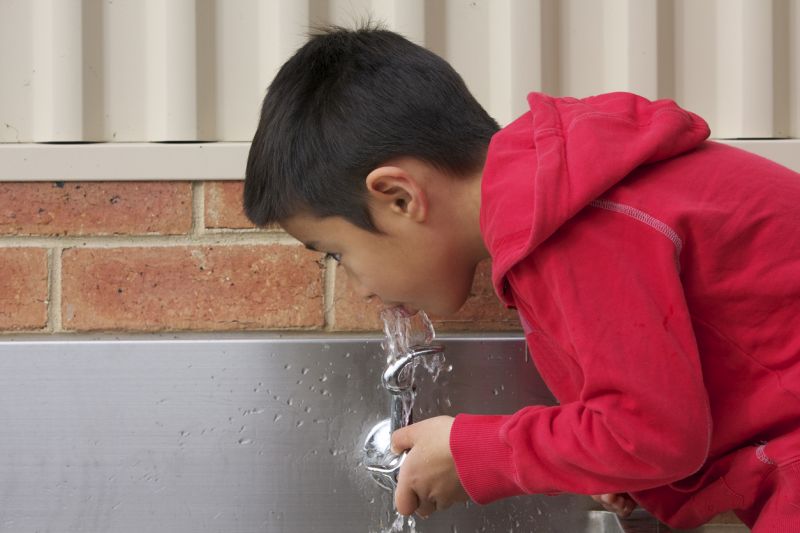The Centers for Disease Control and Prevention (CDC) and other experts agree that there is no amount of exposure to lead that is considered “safe.”
The effects of exposure to lead on the human body are well-known. Young children, especially those age six and under, are particularly susceptible to its effects — behavioral, cognitive and physical — which can be irreversible.
While most lead exposure in children is caused by contaminated paint, dust and dirt, it is generally accepted that about 20 percent of overall exposure results from contaminated drinking water. The presence of lead in drinking water has been a concern for decades. That fear was heightened recently because of the ongoing public health crisis caused by lead contamination in Flint, Michigan's drinking water that began in 2014.
|History of lead legislation & drinking water
The Safe Drinking Water Act (SDWA) was enacted by Congress in 1974 to protect public health by regulating the nation's public drinking water supply. The 1986 amendments to the SDWA set specific standards limiting the concentration of lead in public water systems.
The Lead Contamination Control Act of 1988 (LCCA) required states to establish remedial action programs for the removal of lead contaminants from drinking water systems in schools and day care centers. However, in 1996, the United States Court of Appeals for the Fifth Circuit declared unconstitutional the LCCA's requirement that the states establish remedial action programs for schools and day care centers because it violated the Tenth Amendment (ACORN v. Edwards).
Recognizing that lead enters drinking water primarily through plumbing materials, in 1991, the U.S. Environmental Protection Agency (EPA) published a regulation known as the Lead and Copper Rule (LCR). The LCR required public water utilities to monitor lead concentrations in drinking water, to undertake additional steps if action levels were exceeded, and to then inform the public of steps that should be taken to protect health.
Federal law prohibited consumer use of lead-based paint beginning in 1978. However, the use of lead pipes, plumbing fixtures and solder was not banned until 1986. Even then, brass plumbing fixtures contained significant amounts of lead until 2014.
|How drinking water is supplied
In the United States, 90 percent of the population is provided with drinking water through public water systems. About 80 percent of schools and day care centers also receive drinking water through public water systems.
All public water systems are required to comply with the EPA's Lead and Copper Rule, which requires testing for lead contamination. Such testing is not required of schools and day care centers that do not own and operate their own wells.
Testing in compliance with the LCR is performed before the water enters the public water system. That does not ensure that the water that children drink in schools and day care centers is free from lead contamination. On the contrary, most lead contamination comes from sources inside the building itself, such as lead service lines, pipes, water cooler coils and linings, and leaded metal fountains and fixtures.
In simple terms, the supply of drinking water travels through water mains (primary feeders) to branch lines (secondary feeders) and from there to service lines to individual buildings and residences. The primary and secondary feeders are usually located on public rights-of-way and are serviced by the municipality or other provider. Service lines, however, which run from the feeder to the building, are commonly the responsibility of the owner.

Although schools and child care centers are generally not required to test their drinking water, the EPA has issued guidelines to assist them in determining and reducing lead levels. (Photo: iStock)
|How some public water systems have responded
Many feeder lines were originally installed more than 100 years ago, and were made of lead. Some municipalities, such as Chicago, Ill.; Madison, Wis.; and Lansing, Mich., for example, have replaced all of their lead feeder pipes. However, many service lines are still made of lead, particularly in the Midwest and the Northeast. In the city of Chicago alone it is estimated that 400,000 lead service lines remain in use.
When Madison, Wis., replaced its lead feeder lines, the water utility required all property owners to replace lead service lines at the owners' cost. Unlike most municipalities, Lansing, Mich., also owns the service lines and replaced those along with the feeder lines.
|Current regulation of schools and day care centers
Currently, there is no Federal law requiring that schools and day care centers test their water for the presence of lead. Many states and school districts also have no testing requirements. Short of money, understaffed, and lacking the necessary expertise, schools and day care centers most often do not test their drinking water until required to by some outside agency or event.
It may be assumed that any school or day care building constructed prior to 1986 contains lead pipes, copper pipes joined by lead solder, and brass fixtures containing lead. Even buildings constructed prior to 2014 are still likely to have brass fixtures containing lead.
The estimated cost of removing lead plumbing from older buildings is staggering, totaling tens of billions of dollars. No national plan exists to address the issue; relatively few plans exist at the state or local level.
Lead contamination of drinking water is a particularly acute problem in buildings housing schools and day care centers. Water in the buildings' pipes is frequently not used over weekends and vacations and becomes stagnant. How long water remains in a building's plumbing affects the extent to which lead is leached from plumbing materials and enters the water. Other factors include the chemistry of the water (acidity and alkalinity), the amount of lead with which it comes into contact, and the presence of any protective scales or coatings inside the plumbing materials.
|Steps taken by schools and day care centers
Although schools and child care centers are generally not required to test their drinking water, the EPA has issued guidelines to assist them in determining and reducing lead levels. The three-part process consists of: (1) testing the water, (2) training school and child care center officials to be aware of and identify potential sources of lead and establish a testing plan, and (3) disseminating relevant information.
Some schools and day care centers have taken the simple steps of shutting off drinking fountains and faucets and supplying children with bottled water. Other potential steps include: installing corrosion control devices for individual buildings; installing point-of-use devices that control lead at the tap; and replacing outlets at drinking fountains and faucets that have been identified as sources of localized lead contamination.
So far, however, relatively few schools and day care centers have undertaken the task of testing their water; the majority have not and have no immediate plans to do so. Absent federal or state mandates requiring testing of schools and day care centers for lead contamination in the drinking water, such testing is not likely to become widespread anytime soon.

Failure to conduct testing of drinking water to determine the possibility of lead contamination provides a potential basis of liability of schools and day care centers. (Photo: iStock)
|Potential liability of schools and day care centers
At present, it would be difficult for a school district or day care center owner to assert that it was unaware of the risk of contamination of the building's drinking water supply. The most likely basis of liability would be the failure to either conduct testing of the drinking water for lead contamination or to retain the services of a company with the expertise to do so.
Other potential bases of liability would include failure to properly conduct the testing (which could implicate third-party entities) and failure to undertake efforts to alleviate the contamination. Whether such allegations of liability would circumvent the immunities frequently afforded to school districts under state law for the most part remains to be seen.
|Potential defenses to causation and damages
Claims involving alleged exposure to drinking water contaminated by lead do not always result in significant special damages. Rather, a likely argument is that based on epidemiological studies, the claimant's blood lead level alone is evidence of the probability of neurodevelopmental deficits. Such epidemiological studies have suggested the there is a relationship between blood lead levels and the degree to which intellectual development is affected.
It has not been definitively established that lowering of blood lead levels prevents cognitive deficits. However, such studies have generally not attempted to account for other factors that affect neurodevelopmental risks in children, including poverty, whether the child resides in a single-parent household, whether the child was born to a teen-aged mother, the possibility of child abuse and poor nutrition.
The CDC has questioned the impact of the effects of blood lead levels on neurodevelopmental development. Based on its analysis of statistical models and studies, the CDC concluded that increased exposure to lead accounted for between 0 and 11 percent of the measured variance in the neurodevelopmental status of children. Most commonly, the measured variance was on the order of only 1 to 3 percent. The CDC concluded that other factors, particularly parental intelligence and social class, accounted for much larger variances in the outcomes.
Failure to conduct testing of drinking water to determine the possibility of lead contamination provides a potential basis of liability of schools and day care centers. Although such testing is generally not mandated, concerns over lead contamination of drinking water have existed now for more than 50 years. The lack of applicable statutes or regulations does not preclude the possibility of liability under state common law based on notice of a potentially harmful or dangerous condition of the drinking water.
Questions are likely to remain in individual claims as to the nature and extent of any injuries, and whether and to what extent those resulted from exposure to drinking water contaminated by lead.
Since lead exposure often has no symptoms, it's important to identify and eliminate the risks of drinking water that is contaminated with lead, since it has long been known to be toxic to humans. Accordingly, it would not be surprising if doubts regarding causation and damages were to be ultimately resolved in favor of the claimant.
Michael J. Progar, J.D., is a partner in Doherty & Progar LLC, with offices located in Chicago, Milwaukee, and Northwest Indiana. Doherty & Progar is a member of Your House Counsel, a national consortium of highly qualified insurance and corporate liability defense law firms.
Want to continue reading?
Become a Free PropertyCasualty360 Digital Reader
Your access to unlimited PropertyCasualty360 content isn’t changing.
Once you are an ALM digital member, you’ll receive:
- Breaking insurance news and analysis, on-site and via our newsletters and custom alerts
- Weekly Insurance Speak podcast featuring exclusive interviews with industry leaders
- Educational webcasts, white papers, and ebooks from industry thought leaders
- Critical converage of the employee benefits and financial advisory markets on our other ALM sites, BenefitsPRO and ThinkAdvisor
Already have an account? Sign In Now
© 2024 ALM Global, LLC, All Rights Reserved. Request academic re-use from www.copyright.com. All other uses, submit a request to [email protected]. For more information visit Asset & Logo Licensing.








